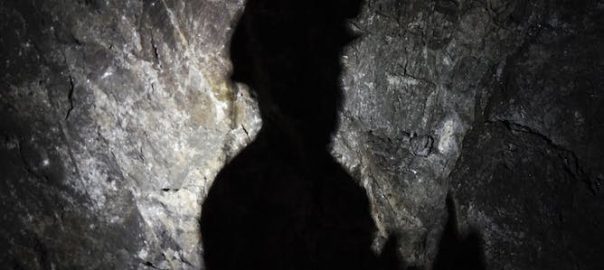On the wooded hill above the Stan Terg lead and zinc mine in Kosovo, there is an old concrete diving platform looming over what was once an open-air swimming pool. Before the break-up of Yugoslavia, people who worked at the mine would bring their families here to swim, sunbathe on the wide terrace with its view across the valley, and picnic among the trees. Now the pool is slowly disappearing into the forest, the view obscured by birch saplings.
I am with Peter*, an Albanian mine worker who used to come up here with his friends before the war began in 1998. Back then, Serbs and Albanians would use the pool and nearby tennis courts together, but there are no Serb mining families here now. Two decades on, the ruination in the landscape still seems unsettling – a reminder for Peter that something valuable has been lost. “I don’t know what the hell happened here,” he says.
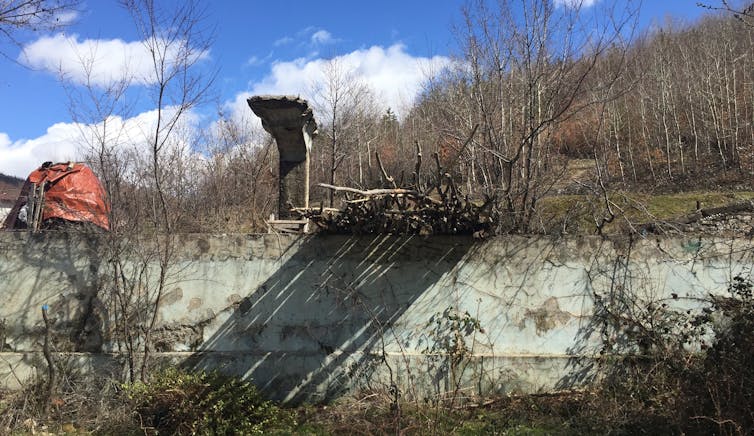
Bridget Storrie, Author provided
As we walk along a winding path he points to a cluster of blue flowers, little starbursts of colour nestled in the dead bracken. “That’s a sign there are metals underneath,” he tells me. They are a quiet reminder of the ore-rich rock that continues to disrupt life in this uneasy corner of Kosovo.
Mines like Stan Terg seem to lurk in the public imagination as remote places that are dangerous, dirty, damaging, violent and destructive. They pollute streams, corrupt politicians, degrade communities and explode indigenous artefacts.
Or they are places where bad people go – those who exploit and extract at the expense of others, human and nonhuman, and are not concerned about the cost. We seem to prefer not to think about them unless we have to.

This story is part of Conversation Insights
The Insights team generates long-form journalism and is working with academics from different backgrounds who have been engaged in projects to tackle societal and scientific challenges.
And yet, we can’t live our modern lives without mining. We may slowly be turning our backs on fossil fuels, but what about all the other geological resources with which our lives are entangled? The mined ore in our mobile phones – those palm-size assemblages of cobalt, lithium, copper, manganese and tungsten. The lead and zinc in our car batteries, the aluminium in our bicycles, the steel in our buildings, and the copper in the hidden networks of cabling that hold our worlds together.
The problem of mining is one for all of us. But what sort of problem is it?
Mining and me
My first encounter with mining came when I worked as a television news journalist for ITN in Moscow. It was 1993, and I was travelling with two colleagues across Russia doing some filming ahead of the upcoming parliamentary elections. We had spent the day in a dilapidated helicopter tracking the Trans-Siberian Express as it wound its way through the birch forests below us. The day ended with an emergency landing in a snow field and a lift back to the town of Irkutsk in a truck.
That evening, we met a group of British men in a gloomy hotel bar. None of them spoke Russian or seemed to have travelled far from their beer glasses. It turned out they were mining engineers on their way to some remote operation further north, pulled to the heart of Siberia by whatever strange thing that mine promised them. Money? Promotion? Easy sex? Theirs wasn’t a world I wanted to be part of.
Little did I know. Two years later, overwhelmed after the war in Chechnya, undone by a conflict with a colleague and reeling from a failed relationship, I fell out of my journalistic life and landed in a small seaside town in Namibia with a baby daughter and a man I’d married but barely knew. He was a mining engineer who drove 60 kilometres inland each morning to the uranium mine that had operated there since 1976.
Suddenly everything about my life – where I lived, who I met, what I did, how I felt – was mediated by a vast, contentious, spiralled hole in an ancient desert that most people preferred not to think about. I was a white mining wife sucked into a strange world of bake sales, coffee mornings and housing officers who matched the quality of homes offered with the importance of our husbands’ jobs. We were not at the top of the pile.
On our first weekend, my husband’s throat was cut by three young men trying to break into the small, terraced house we had been allotted. He saved his own life by drawing on his training with the Royal Marines, holding his slashed neck together, keeping his pulse low and only collapsing when he made it into the back of the ambulance.
The police told us the men were from Angola, drawn to this area because of the uranium and the wealth it had created. You can’t live near a mine without being aware of the inequalities it encourages.
Since those early days in Namibia, we have moved from mine to mine around the world, making and remaking our lives in the US, South Africa, Australia, Canada, Mongolia, Serbia, then back to Canada again. With each move, I have thought more about the complexities, controversies and conflicts that surround resource extraction. Were we making our own lives at the expense of others?
Whether it’s uranium in Namibia, lead and zinc in Kosovo or copper in the Gobi desert, all geological entities become disruptive once they are mapped out and given value. Earlier in 2022, Rio Tinto – the world’s second-largest metals and mining corporation – had its exploration licences revoked by the government of Serbia after thousands of people took to the streets, demanding that the development of a lithium mine should stop on environmental grounds.
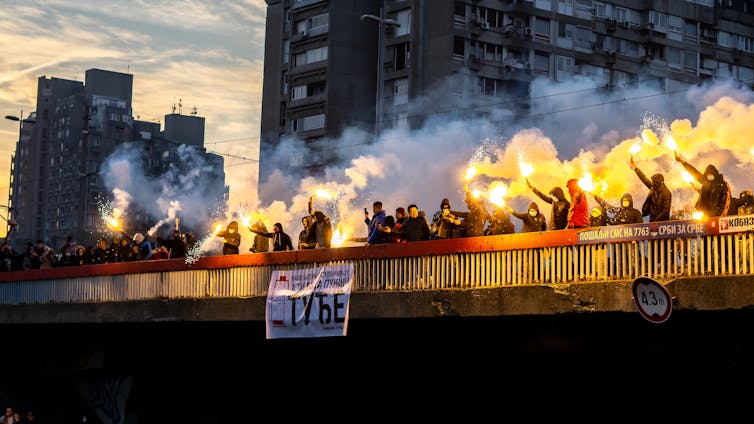
Shutterstock
We left Belgrade in 2018, before the project became controversial, but for seven years we had been deeply involved with the complexities of mining in the Balkans. My husband led the Rio Tinto team in Serbia, and I was working on my PhD research at Stan Terg exploring the relationship between mining, conflict and peace. We would be on the wrong side of public sentiment if we lived and worked there now. That’s an uncomfortable feeling – not because it makes me think my association with mining puts me on the moral low ground, but because it’s frustrating.
No easy answers
The mining industry is changing, driven not just by international standards and external pressures but by internal forces too. I’ve met botanists, ornithologists, ecologists, archaeologists, former teachers, people who used to work for NGOs, and a host of others in the industry who are all, in their own ways, wondering how to improve things. That’s not to argue that power rests in their hands, but there is more in common between some of the people who work within mining and those who oppose it than might be imagined.

Shutterstock
The frustration is that focusing entirely on the environmental and social harms caused by mining risks avoiding the true extent of the challenge mining presents us with, and the complex ways we are all tied up in it because of our consumer appetites.
If building a lithium mine is unacceptable in Serbia as a means to satisfy our demands, what does that mean for the lithium-rich salt flats in Chile and the Indigenous groups living there who are concerned about the impact of mining on their water sources? Or for the lithium under Mariupol in Ukraine that was attracting international attention before the war?
When Serbia’s tennis hero Novak Djokovic tweeted photos of the protests along with a declaration that we need “clean air”, I wanted to rest my forehead on my desk. He’s right, of course we need clean air. But the lithium required to achieve it must urgently come from somewhere.
The problem is in many sectors we need more mining, not less, for the transition to a zero carbon future. The World Bank has predicted that the production of graphite, lithium and cobalt will have to increase five-fold by 2050 if climate targets are to be met, and the demand for lithium-ion batteries already has analysts describing lithium as “white oil”.
In April 2022, US president Joe Biden used a cold war-era law – the 1950 Defense Production Act – to boost the production of lithium in the US, along with nickel and other minerals needed to power our electric vehicles.
Similarly, copper is integral for key large-scale decarbonisation technologies such as offshore wind projects. Working out how to source these materials has been made more urgent by the war in Ukraine, and the need to reduce dependency not only on Russian oil and gas but on its minerals and metals too.
After 26 years, I have learned that all mining operations – actual and potential – require us to pay attention to what is most difficult about our lives: how what we consume relates to the future of the planet and the lives of those we share it with. The problem of mining is not just one of how we should extract, but how we should live.
A story of optimism and attachment
The people I met at Stan Terg in 2018 told me a story about mining that was not just about dirt, degradation and pollution, but also their enduring attachment to the mine and what it promises.
Stan Terg is the oldest mine within the huge, decaying Trepča industrial complex – an ecology of mines and related infrastructure concentrated in the northern part of Kosovo. This small mine tucked away up a wooded valley, ten kilometres north-east of the town of Kosovska Mitrovica, was first developed by a British mining company in the 1920s, shortly after Serbia’s reconquest of Kosovo.
When the British travel writer Rebecca West visited here in 1937, she was enchanted by the English-style mining cottages with their unguarded front gardens and windows facing the road, reflecting the setting sun. To West, these houses expressed confidence that the mine would bring not only prosperity but also peace to this troubled region. Its Scottish general manager employed both Serbs and Albanians and was certain they would work well together. “This country,” he told West, “is getting over its past nicely.”
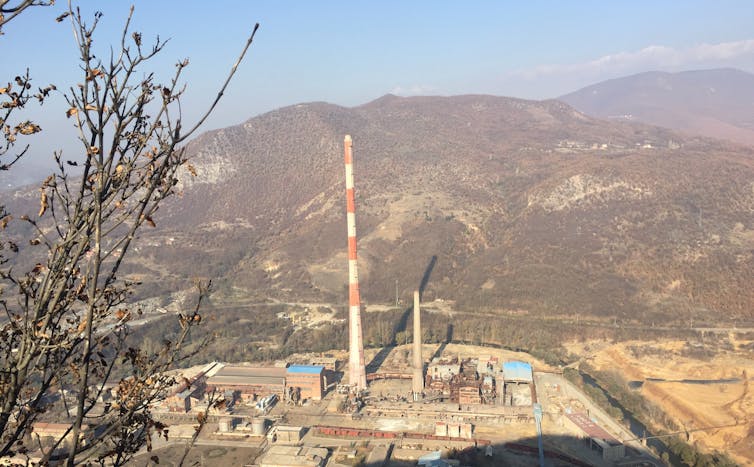
Bridget Storrie, Author provided
Nearly 90 years later, the ruins of the houses that delighted West still exist above the Stan Terg mine, but they are pitted with bullet holes. While the war between Serbia and Kosovo in the late 1990s was not (ostensibly) over natural resources, a strike by the Albanian mineworkers at Stan Terg in 1989 was part of the political upheaval that preceded the violent break-up of Yugoslavia and ultimately led to Kosovo’s declaration of independence in 2008.
Now this part of Kosovo is uneasily divided. Four Serb-dominated municipalities close to the border are still de facto ruled by Belgrade. The town of Kosovska Mitrovica, once the bustling, multicultural, industrial heart of this region, has been bisected – Serbs largely to the north of the river Ibar with their language, dinar currency and orientation towards Belgrade; Kosovan Albanians to the south.
But it is not just people who are divided here. Trepča’s smelter, flotation plant and three northernmost mines are also under Belgrade’s control. Settling the future of the complex is an explosive issue: a mining complex that once promised to bring people together is now pushing them apart – lending its geological heft to a conflict that has become intractable.
Yet the Kosovan-Albanian workers at Stan Terg are still optimistic that their mine can change things for the better. “I feel hope when I go down the mine,” one tells me. Another says it is a pleasure to work in the place that will one day make the economy better. A third describes the feeling he had when he returned to the mine after the war once the Serbs had left: “There was no happiness like it. It wasn’t just that I was going to get paid, but Kosovo was going to get stronger too.”
This is not an easy optimism to hold on to, however. It is contradicted by the ruination around us – the destroyed cinema, collapsing hotel and crumbling diving board – and by the mineworkers’ acknowledgement that life is not how they expected it would be. A tearful man worries that he made a mistake when he brought his family back here after the war. Another struggles to breathe because of the damage to his lungs. “The mine produces cripples,” he tells me.
Yet despite the destruction, pollution and disappointment, the mineworkers still insist that the lead and zinc rich rock beneath them is a “gift from God”, and that it will bring them all prosperity in the end.
Talking with these mineworkers, I realise that what is important here is the painful and profound process of creating worlds and hoping they will last; coping with the disappointment when they don’t; and remaining optimistic that a mine will deliver some sort of good life amid the evidence it never has – at least not for long.
A problem of world-making
Mining is not just a problem of extraction and the environmental degradation associated with it. It is also a problem of world-making. What sort of worlds do we want our geological resources to create for us? Who are they for? How long will they last? And who, and what, might suffer because of them?
It is tempting to think this problem is a local one – something that happens “over there” on the shores of an Arctic fjord, in the Namibian desert, in a taiga forest in the heart of Siberia, or in semi-recognised geopolitical entities with travel advisories like northern Kosovo.
Yet metals and minerals promise to make the world different for all of us. The lithium in our antidepressants. The stainless steel in the needles of our syringes that deliver vaccines, anaesthetics, Botox. The aluminium in our heat pumps, the copper in our wind turbines, the titanium in the Mars Exploration Rovers and the gold in the James Webb telescope. They all bring certain futures into view and allow us to feel confident about them: that we won’t be sad, that we won’t age, that we can achieve net-zero carbon and look after the planet – even that we can find an alternative world to escape to.
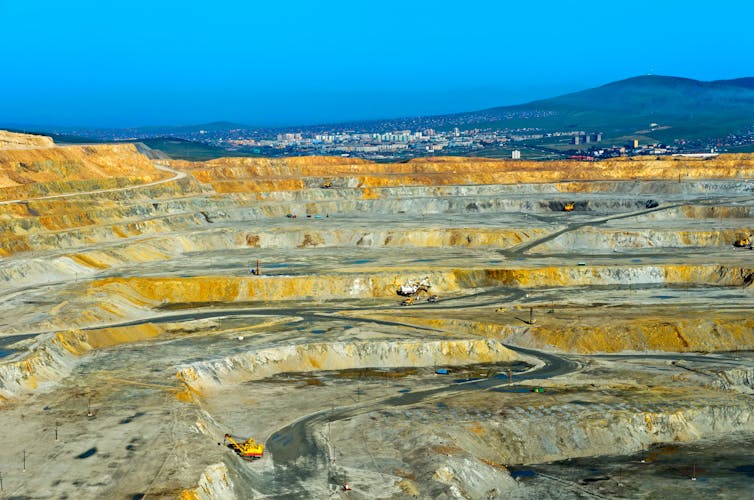
GFC Collection/Alamy
But they do so at a cost. The global hypodermic needles market is estimated to reach US$4.5bn by 2030. Europe’s aluminium smelters are facing an energy crisis while China is ramping up its production based on an increase in coal production. The war in Ukraine is threatening to disrupt titanium supplies. Demand for copper is predicted to double to 50 million tonnes by 2035, but supply is unlikely to keep up and the net-zero transition might be delayed as a result.
According to Dan Yergin, global vice-chairman of the S&P business intelligence group, we can’t assume that copper and other metals and minerals “will just be there”. New geopolitical worlds are likely to emerge in the rush to acquire them.
Like the miners at Stan Terg, are we attached to an idea of the world that is not the same as the one we live in?
For now, the lithium and borates-rich rock under the Jadar valley in Serbia is being pulled in all directions. People interested in protecting the environment want it to stay in the ground. A local farmer understandably wants to preserve his land. Yet we need to unearth vast of amounts of lithium from somewhere if we are to swap our petrol cars for electric ones.
Meanwhile mining company shareholders expect their dividend cheques, politicians want to be re-elected, people need to feel they are listened to and have some control, and everyone, in their own way, wants to prosper. This geological body, like any other, is asking questions that are hard to answer. Whose future counts? And at what cost?
At the bottom of their world
Before leaving Stan Terg I travel down to the bottom of the mine, three-quarters of a kilometre underground. The mineworkers – all men – have told me I cannot properly understand their world unless I experience it.
I watch the wet walls of the mineshaft slip past as we descend, notice the drips of water on my helmet and a deep bass hum coming from somewhere I cannot place. I am travelling back in geological time, past rocks that are increasingly ancient as we descend. For we don’t just possess tiny pieces of Kosovo, Siberia or Alaska in the smartphones in our pockets, but elements of the deep past too – minute reminders that the world we create with them should be enduring.
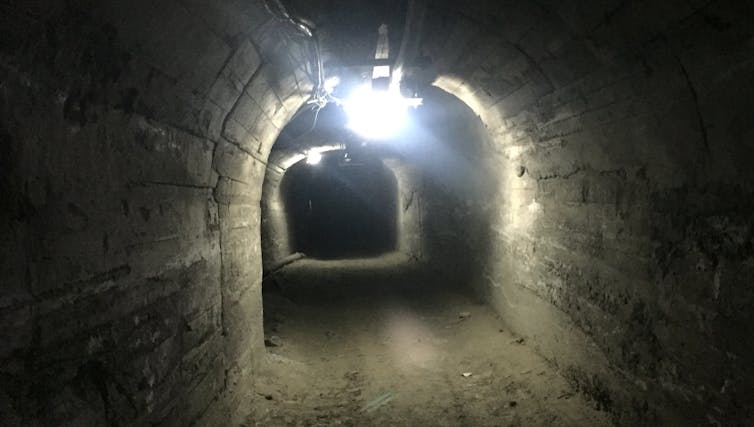
Bridget Storrie, Author provided
I feel disoriented at the bottom of the mine, but the workers are intimate with this place. They tell me they feel good down here. I watch as they stride off along the tunnel, their boots splashing in the water.
For them, the rock around us is like a human body with veins of minerals and the capacity to expand and contract as if it is breathing. They listen to the noises it makes and understand what it says to them. After so many years, they know the sound of danger.
But this mine also holds their memories of the days when Serbs and Albanians worked together here before the war, and of the trust that emerged between them deep underground. “There are no ethnicities in a mine,” one worker tells me, “just miners.” Another says he’d like to see his old colleagues again, although he knows not everyone would agree with him.
There is optimism here, of sorts: “The problem started in Trepča and the solution will be found here too,” I am told. “If we learn how to develop Kosovo together, peace will happen.”
Yet for all their familiarity with this place, it still has the power to surprise them. Every day they find something ancient and unexpected sparkling in the light of their headlamps. There are thousands of breathtakingly beautiful crystals down here, and none of them are the same.
They are powerful objects, these crystals. I have a collection on my windowsill at home: palm-sized silver and white spines of quartz, pyrite and a host of other materials – disrupting what we think we know about mining, what we might expect to find at the bottom of a lead and zinc mine in the context of conflict, and how people might think and feel when they are down there. There is more to this world, they seem to say, than we might imagine.
*Research participant’s name changed to protect their anonymity

For you: more from our Insights series:
-
‘Too afraid to have kids’ – how BirthStrike for Climate lost control of its political message
-
How a Soviet miner from the 1930s helped create today’s intense corporate workplace culture
To hear about new Insights articles, join the hundreds of thousands of people who value The Conversation’s evidence-based news. Subscribe to our newsletter.
Bridget Storrie, Post-Doctoral Teaching Fellow, Institute for Global Prosperity, UCL
This article is republished from The Conversation under a Creative Commons license. Read the original article.

